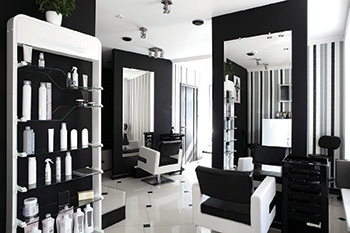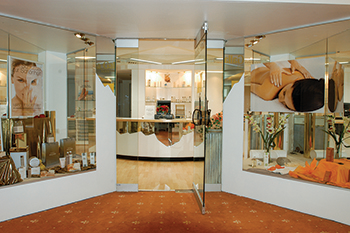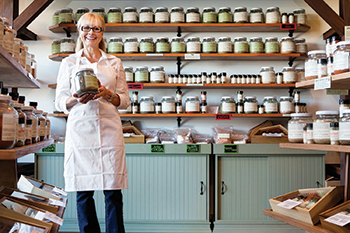Typically, retail product sales will contribute between 3 and 10 percent to gross sales. While it is tempting to focus primarily on the treatments and technology a spa offers, ignoring retail space erodes the bottom line. If a spa is making less than 10 percent of gross sales from retail, it is neglecting both retail space and profit potential. With training, a spa can realize a return of 30 to 40 percent. For those not hitting such numbers, here are some strategies and tactics to help.
A successful spa should know their service to product sales ratio. For every $100 of services sold, they should sell at least $30 of products. Why are product sales so important? Product sales not only have a substantial positive impact on gross sales, offering retail products helps bring existing customers back through the door for replenishment and additional services.
 ASSESSING CURRENT EFFORTS
ASSESSING CURRENT EFFORTS
To maximize the profit potential of a spa’s retail space, it is important to formulate a retail strategy. Professionals should ask themselves these questions to help flush out a basic strategy:
- What types of services are currently offered? Look at financial metrics and align product offerings with services.
- What are the goals and objectives of the retail space? Is the primary goal to increase gross sales and profitability through product sales or bring customers back in? Should the product be a known brand or the spa’s own private brand?
- Where is retail space located and how does staffing affect it?
Let’s look at each of these in more detail. Aligning retail offerings with service categories makes sense. For instance, if focused on skin care treatments, consider offering skin care products. If a spa offers body sculpting and weight loss services, it may be more effective to offer body care products, along with nutraceuticals. Also consider ancillary add-on support products, such as applicator brushes, skin cleansing aids, and so forth. If products align nicely with the treatments provided, it naturally creates an opportunity for seamless selling.
Understanding retail sales goals will help = focus on those things that best fit. It is easy to overwhelm clients by having too many untargeted offerings. Retail space should not resemble the health and beauty aisle of a big-box discount store. The goal is to have a well-planned, highly-targeted, and profitable product selection.
It is critical to consider a target market and the spa’s positioning in the marketplace. Is it a high-profile spa with an upscale client base? Or, is the client base moderate income and value driven? Analyzing the target market will help determine whether a spa should offer primarily ultra-premium products, including its own private label line; a more moderately priced branded line; or if the spa should lean toward a more economical line.
 HONING A HERO PRODUCT
HONING A HERO PRODUCT
Regardless of positioning, offer a hero product. A hero product is one which resonates well with target consumers. It is the most efficient and effective product within a category and gives visible results. A hero product should provide the spa with a good profit margin. Overall, spa consumers have shown very strong loyalty to facial products, so this is an excellent category for a hero product. Using a hero product as the first step toward a private label line is a good idea. It is not uncommon for a private label hero product to cost $30 and retail up to $250.
Launch a private label hero product and then slowly build a line by adding a new private label product or two each quarter. Private label offerings are not only highly profitable, but they keep the spa’s name in front of customers on a daily basis. To get the most out of a private label line, it is critical that they suit target consumers. Understanding the target market is essential, as is the use of appropriate packaging to position the products for that consumer.
 DAZZLING DISPLAYS
DAZZLING DISPLAYS
Once the types of products the spa plans to offer has been considered, it is time to reflect on another important question. Where are products being sold? And, who is selling them? These two, often overlooked, considerations represent the largest mistake a spa can make.
Unless designing a new facility or are looking for new location, where retail products are located is dependent upon the size of the facility, security concerns, available manpower, and inventory storage. Ideally, a primary retail area will be adjacent to the spa checkout area because this area is usually staffed at all times and is an area where a staff member routinely engages the client one-on-one.
This provides an opportunity to educate the client about the products the spa offers that complement the treatment the client has had. Staff members should be knowledgeable and able to answer questions about not only the treatments offered, but also about the products available. Clients do not want to be sold products. They want to be educated about what products are available to help them maintain the benefits of their treatments. Training is important, so staff members can master the art of educating clients.
Another consideration is retail product display strategy. Unless a plan is made for how products will be properly displayed, money will be wasted. Display products at eye level, especially the hero product. Customers should also be able to reach the products easily and lighting is important. Take care that the display lighting, or sun coming in a nearby window, does not get so hot that it causes discoloration or melting of products. Instead, design lighting which shows off the display rather than detracts from it. Be sure to maintain the display, too. Dust the shelves, replenish products as necessary, straighten products, and refresh the overall appearance to reflect the season.
It is also important to have the necessary stock to handle clients’ purchases, but not so much that an unnecessary amount of working capital is tied up. Stock should be secured to prevent loss – an accurate yet simple inventory system maintained – and it should be rotated for freshness. Display enough for visual appeal, but not so much that the retail area resembles a warehouse store. Inventory should be stored out of sight and the display area restocked frequently. The aesthetics industry is a rapidly advancing field with new product offerings all the time. Do not have so much inventory that products cannot be introduced – better products as they become available.
Keep in mind, the spa has a story to tell. Use posters, images, and graphics to help tell that story. What is each product for? Consider displaying products based on categories, such as facial products, eye products, body products, men’s products, and so forth. Consider adding a section for youthful (teenage) skin. Think about signage and collateral sales materials (brochures). Where will they be placed?
Consider using shelf talkers – messages that call the buyer’s attention to a particular product displayed. A shelf talker is a silent sales person. The key to effective shelf talkers is that they must be large enough to be easily readable and communicate the necessary information, but not so large they distract from the overall display. Shelf talkers should be easy to read, easy to understand – use layman’s terms clients can understand – and they should include information on how the product should be used, expected results, and a list of ingredients.
Another sales tactic is to bundle retail items into a package with series of treatments. For example, include a skin care home maintenance kit with a series of skin treatments. Also, consider bundling retail products into gift baskets. Body care products are very popular holiday gift items. Having ready-made gift baskets or bundles can boost sales. Also, consider including a gift card for a treatment with the gift sets. Change up displays periodically. Think seasonally. Facial products are more seasonal. Moisturizers sell best during cold weather seasons, while sunscreen products sell best in spring and summer.
TEACHING WITH TESTERS AND SAMPLES
Another thing to consider is the use of testers. This can be effective because it allows clients to try the product, which engages more of their senses. Keep in mind, offering testers can sometimes be messy, so keep them organized neatly in a separate area of the display. Be sure to clean and maintain the area.
Offering take-home product samples can be an expensive proposition which seldom generates additional sales on its own. Sample techniques that are more likely to increase sales include offering a product sample with a purchase. For example, if a client purchases a facial serum, give them a sample of a facial moisturizing product. Complimentary samples should be samples of higher profit margin products and of key, core products such as layering products – a cream layered over a serum, for example. Drive products that give the fastest results and have the highest profit margin.
To benefit from sample-driven sales, having an educated sales person is critical. A well trained, knowledgeable sales person can not only educate the client, but can drive sales through effective technique. For example, have a client try a sample on the back of one hand, then, have them compare that hand with the untreated one. With sampling, it is also important to develop a method of follow-up with clients. At that time, inquire not only whether or not they need to replenish the facial products they purchased, but also ask if they benefited from using the sample and if they would like to include that product with their next order. A top notch sales person will keep notes and use that information to drive future sales. This can be done by offer discounts on related products during a future visit.
SELLING IN THE TREATMENT ROOM
Within each treatment room there should be one or two retail items displayed, with supporting literature, which are a natural complement to the type of service being offered. This allows the professional the opportunity to soft sell the product by mentioning it casually during interaction with the client. Do not overwhelm the customer by trying to display everything in each treatment room and do not engage is hard sell tactics. Those are counter-productive tactics, but make no mistake, sales of retail products start in the treatment room. Displays should be changed up periodically and replaced with different product offerings so they are always up to date and fresh. This helps educate clients about the many different products offered, as well as ensuring there is something new and interesting to catch their attention. Consider making use of seasonal displays.
If the spa has a conference room or a private area for consultations, and the staff to handle them, consider adding some retail display items there, also. For best results, the client and the staff member should be seated during the consultation and product demonstration. Being at the same level promotes eye contact and helps a client engage more – the more engaged, the greater the likelihood of purchase. Another factor which effects purchase readiness is comfort. The environment should be relaxed, not too hot or cold, lighting should be appropriate, and the chair comfortable. Amenities to consider include a sink, if possible, or a cleansing light for sanitary purposes. A mirror is critical, so the client can see themselves as they are applying facial and eye products. Also, be mindful of licensing requirements to which the spa must conform.
It was mentioned earlier that selling starts in the treatment room and soft sales should not wait until the end of the treatment to occur. Some ways to soft sell during treatments include asking the client how they are currently taking care of their skin, then discussing skin care maintenance using the products the spa sells. Remind clients during the treatment that skin care maintenance is an ongoing, daily necessity that should be engaged in morning and evening, much like brushing teeth. Another soft sell technique is to ask the client what changes they would like to see in their skin that the spa can help them achieve. This opens the door to educate the client about appropriate product offerings in a non-threatening way. Less is more in this case. Do not overwhelm the consumer by talking about every product, instead offer information on one or two appropriate products.
REACHING A VARIETY OF CLIENTS
Consider reaching out to underserved markets. Most spas’ retail areas most likely focus almost exclusively on women. Why not add a section for men and a section for teenagers? Women usually learn about skin care from their mothers, but men and teenagers need training.
Men are curious about skin care, but, often, do not know how to do it. Develop a whole educational program for them. Make it gender specific and masculine. Perhaps offer a men’s skin care education night. Create men’s skin care bays with a masculine look. With men, education is starting at ground zero, so keep to the basics, such as washing their face at least twice daily. At a men’s basic skin care event, do not overwhelm a man by discussing five or ten different products. Instead, focus on two or three. Work on building a relationship.
Another reasonably untapped market for spas is the teenage skin care market. Most teenagers rely on discount stores for acne treatments or dermatologists. Teenagers are image conscious. It is important for them to look good; they do not want to be embarrassed by blemishes and acne, but they do not have a solid understanding of skin care and blemish prevention.
Offer a teenage skin care seminar, possibly an after-school or early-evening weeknight event. Encourage parents to attend with their teenagers; after all, teenagers may not be willing to part with their own money as readily as they are to part with their parents’ money. Keep the event short and limit the number of products showcased. Teenagers have a short attention span. Perhaps a 15-minute presentation on basic skin care and blemish prevention and a 10-minute question and answer session are adequate. At the event, offer appointments for skin care treatments. These appointments should be available within the next few days. Consider offering educational information focused specifically on teenage skin care on the spa’s website. Let parents and teenagers know that they are welcome to come to the spa for skin treatments when they need them because it can take weeks to get into a dermatologist’s office and that can be a lifetime to a teenager with zits.
As a spa markets retail to diverse client types and considers its sales strategy, product placement and displays, and its efforts to teach clients about available retail during treatments and through testers and samples, bottom line and client satisfaction will improve.
Cheryl Whitman, founder and CEO of beautiful forever Aesthetic Business Consulting, has, for more than three decades, been the internationally recognized pioneering leader in the challenging field of aesthetic business development and marketing consulting – working with hospitals, spas, anti-aging centers, and physician practices to achieve dramatic results. Whitman’s diverse background enables her to provide her clients with the highest level of personal attention, along with top-notch consulting support.